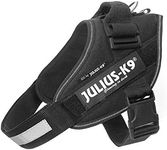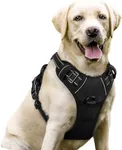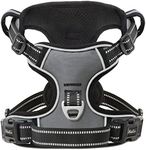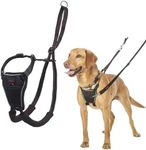Buying Guide for the Best Dog Harness
Choosing the right dog harness is essential for ensuring your dog's comfort and safety during walks and other activities. A well-fitted harness can prevent injuries, provide better control, and make outings more enjoyable for both you and your dog. When selecting a harness, consider your dog's size, breed, and specific needs. Here are some key specifications to help you make an informed decision.SizeSize is crucial when selecting a dog harness because it ensures a proper fit. A harness that is too tight can cause discomfort and restrict movement, while one that is too loose can lead to escape or lack of control. Sizes typically range from extra small to extra large, and it's important to measure your dog's chest and neck circumference to find the right fit. For small breeds, look for harnesses designed for petite sizes, while larger breeds will need more robust options. Always refer to the manufacturer's sizing chart and consider adjustable harnesses for growing dogs.
MaterialThe material of the harness affects both durability and comfort. Common materials include nylon, polyester, and leather. Nylon and polyester are lightweight, durable, and often more affordable, making them suitable for everyday use. Leather harnesses are more durable and can be more comfortable for some dogs, but they require more maintenance. For dogs with sensitive skin, look for harnesses with padded or mesh linings to prevent chafing. Consider your dog's activity level and environment when choosing the material; for example, waterproof materials are ideal for dogs that enjoy swimming.
TypeThere are several types of dog harnesses, each designed for different purposes. Back-clip harnesses are the most common and are suitable for well-behaved dogs that don't pull. Front-clip harnesses provide better control for dogs that tend to pull, as they discourage pulling by redirecting the dog's movement. Dual-clip harnesses offer versatility with both front and back attachment points. Step-in harnesses are easy to put on and take off, making them ideal for dogs that dislike having things put over their heads. Choose the type based on your dog's behavior and your training needs.
AdjustabilityAdjustability is important for achieving a secure and comfortable fit. Harnesses with multiple adjustment points allow you to customize the fit to your dog's unique body shape. Look for harnesses with adjustable straps around the chest, neck, and sometimes the belly. This feature is especially useful for growing puppies or dogs with unusual body shapes. Ensure that the harness can be adjusted easily and stays in place once adjusted. A well-adjusted harness will prevent slipping and ensure your dog's safety during walks.
PaddingPadding adds an extra layer of comfort, especially for dogs that wear their harnesses for extended periods. Padded harnesses can prevent chafing and distribute pressure more evenly, reducing the risk of injury. Look for harnesses with padding in key areas such as the chest and back. This is particularly important for dogs with sensitive skin or those prone to rubbing. If your dog is very active or participates in activities like hiking, a padded harness can provide additional comfort and protection.
Reflective FeaturesReflective features enhance visibility during low-light conditions, making walks safer for both you and your dog. Reflective strips or stitching can help drivers see your dog from a distance, reducing the risk of accidents. This is especially important for evening or early morning walks. If you often walk your dog in the dark, consider harnesses with built-in reflective elements. These features can be a lifesaver in ensuring your dog's safety during nighttime outings.
















